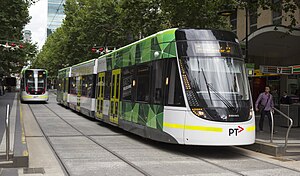E-class Melbourne tram
| E-class | |
|---|---|

E 6001 & E 6002 on Bourke Street in December 2013
|
|
| Manufacturer | Bombardier |
| Assembly | Dandenong |
| Constructed | 2013–present |
| Number in service | 47 with 1 under testing and commissioning (February 2017) |
| Fleet numbers | E 6001-E 6070 |
| Capacity | 64 (Seated) 146 (Standing) |
| Depot(s) |
Preston Southbank |
| Specifications | |
| Train length | 33.45 m (109 ft 9 in) |
| Width | 2.65 m (8 ft 8 in) |
| Height | 3.65 m (12 ft 0 in) |
| Low-floor | Yes |
| Doors | 10 (five per side) |
| Articulated sections | 2 (three sections) |
| Maximum speed | 80 km/h (50 mph) |
| Weight | 62 t (61 long tons; 68 short tons)(with passengers) |
| Acceleration | 1.3 m/s2 (4 ft/s2) |
| Electric system(s) | 600 V DC Catenary |
| Current collection method | Pantograph |
| AAR wheel arrangement | B'B'2'B |
| Bogies | 4 (B'B'2'B) (3 powered, 1 unpowered) |
| Track gauge | 1,435 mm (4 ft 8 1⁄2 in) standard gauge |
The E-class trams are three-section, four-bogie articulated trams that were first introduced to the Melbourne tram network in 2013. They are being built by Bombardier's Dandenong factory, with the propulsion systems and bogies coming from Bombardier factories in Germany.
The E-class is part of the Tram Procurement Program, a Public Transport Victoria project aimed at increasing capacity and reliability of the tram network through the introduction of new trams, creation of new depot space, and upgrades to existing infrastructure. In September 2010, 50 were ordered with an option to purchase a further 100. In May 2015, a further 20 were ordered which will take the total to 70.
The first tram was delivered in June 2013 and after testing entered service on route 96 on 4 November 2013. As of 9 February 2017, forty-seven were in service with one undergoing testing and commissioning.
In July 2009 the Victorian Government called for expressions of interest for the construction of 50 new trams. The expression of interest stipulated that the trams be low floor to comply with the Disability Discrimination Act, that 40% of the total contract was to be local content and that the first were to enter service in 2012.
In October 2009 Alstom and Bombardier were shortlisted to bid for the contract. The invitation to tender stated the contract had been declared a strategic project, requiring a minimum 25% local manufacturing content, and 50% local content over the life of the contract, with 150 jobs expected to be created.
Bombardier were awarded a $303 million contract for 50 Flexity Swift low-floor trams, with maintenance to 2017 in September 2010; the contract includes an option for a further 100 vehicles. They are being built at Bombardier's Dandenong factory with local design input, including aesthetic design by Bombardiers Brisbane based Industrial Design team with propulsion systems and bogies coming from Bombardier’s German factories in Mannheim and Siegen respectively. They are the first trams built in Australia in 12 years, and the first locally built Melbourne trams since the last B-class was delivered in 1994.
...
Wikipedia
